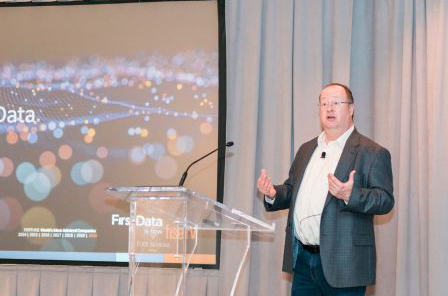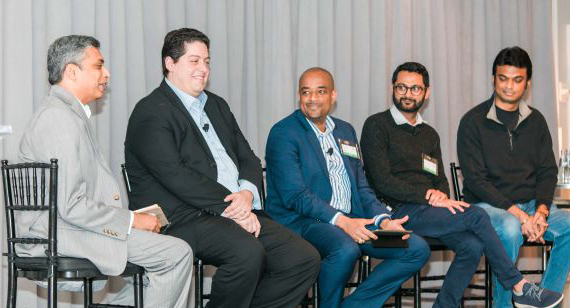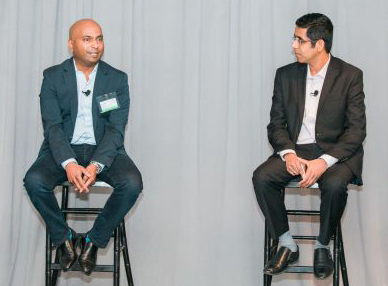The Roadmap to Optimal Analytics Maturity
Excerpts from LatentView’s Twelfth Analytics Roundtable in San Francisco
Keynote address: Fiserv’s journey in data
Speaker: Glenn Fodor, SVP, Competitive Intelligence, Fiserv

Glenn had participated in LatentView’s 10th Analytics Roundtable in San Francisco in October 2018. At that event, Glenn talked about the digital transformation taking place at First Data. Since then, First Data was acquired by Fiserv, and as this year’s keynote speaker, Glenn shared where Fiserv fits today in the value chain across its merchant clients. The credit card transactions that Fiserv processes account for trillions in spending. For context, that is over 10% of U.S. annual GDP. Their challenge is, how can we monetize all their data?
The answer for Fiserv was to first understand and categorize the different types of data they had. This includes:
- Collected data: data collected at the point of sale (transaction size, credit card type, credit card brand, channel e.g. e-commerce or in-store, fees, etc.
- Enriched data: new data that is created using third-party existing structured and unstructured data (demographic info, weather, social media)
- Derived data: data they calculate using analytics from the first-party data they have (cardholder zip code, market share, customer segmentation)
Fiserv’s small merchant solution (launched in 2013) generated a lot of data, and over time, the company had learned to curate, cleanse and store that data. Today, they are using data to help solve pain points for small merchants like local restaurants and retailers. Card transaction data can tell merchants, for example, where customers live and that can be used for targeted ad campaigns or even insights on where to open a new location. One ice cream store was able to realize through data that they sold more ice cream on rainy days than sunny days. Those are valuable insights being used to make business decisions.
For large merchant efforts, it was more of a challenge to scale their data efforts because of their inability to do custom engagements. Yet, there were still significant opportunities to offer Data-as-a-Service and all types of insights that enterprise merchant data could provide — from macroeconomic trends around holiday spending to food consumption around the Super Bowl. The challenges came with the legal and regulatory parameters around selling data (as well as client requirements), and a lot of lessons were learned around data discipline. Glenn stressed that not every shiny object (possible use of data) should be chased.
Glenn made the important point that data is not always easy. It requires companies to think about data quality, governance, and storage before they can consider commercialization. Fiserv’s driving philosophy today is about moving away from a siloed approach to data and properly prioritizing investments in data solutions. Glenn concluded with key recommendations for others who are undertaking data initiatives with an eye on analytics maturity.
- Take careful inventory of both your data and talent
- Decide how your organization is going to solve data changes (horizontally, vertically, or a hybrid organizational approach)
- Understand the legal and regulatory lens you’re subject to with data
- Determine your organization’s risk appetite
- Identify your end goal for every project (increase revenues, cut costs, drive innovation)
- Understand the needs and problems of your constituents
- Obtain complete buy-in from leadership from the start
- Set expectations accordingly
Panel discussion: How to build a data-driven organization
Simon Benarroch, VP, Global Marketing Analytics, Visa
Yelak Biru, Senior Director of Data and Analytics, Walmart
Abhi Gupta, Head of Analytics and Strategy, Hotwire
Kanthi Muthiah, Global Chief Product Officer, Merchant Lending, PayPal
Moderator: Sekhar Krishnamoorthy, Chief Product Officer, LatentView Analytics

Data has been called many things: the new oil, the new currency, etc. Everyone believes that data has the power to provide insights that enable a competitive edge, but for many companies today, there’s a big gap between data analytics and action. In this panel, executives from Visa, Walmart, Hotwire, and PayPal shared thoughts and strategies around building a data-driven organization based on their firsthand experience. The panel discussed the biggest changes in data and analytics over the past 5 years, the critical roles and skill sets needed to build a data-driven organization and touched on the important topic of data ethics and privacy.
Simon Benarroch from Visa said it was important for companies to connect two sides of an organizational equation: people who are data experts and those who understand where that data can make a business impact and drive revenue. In many ways, this is a 1+1=3 equation where the combined power of both sides generates the potential for exponential outcomes. Simon noted that data analysis is useless without the insight and influence to create change. He advised, “Start with a business problem and engaging with a business decision-maker and work backward from there; it’s difficult to start with the data first.”
Yelak Biru from Walmart echoed the idea of not starting with data first. He shared that at Walmart, trying to start with data slowed them down. He suggested it’s better to first engage with business decision-makers that can help prioritize what data should be tackled. Yelak said that when it comes to utilizing customer data, the basics are unchanged. Companies need to understand what customers are doing and establish trust by demonstrating they are using data in the customers’ best interest. Regarding trust and privacy, he noted, “Treat customers and customer data in the same way you would want another company to treat you.”
Abhi Gupta from Hotwire highlighted the importance of bringing disparate teams together as the key to leveraging true analytics insights, or what he calls “actionable intelligence.” He said that this requires understanding the organization’s culture and what’s really happening internally, as well as uncovering the 3-4 big drivers of intelligence. When building out an analytics strategy, it’s critical to have a multi-year vision based on business objectives and to demonstrate to C-level decision-makers how analytics will get you there. He recommended, “When analysts come up with ideas, they need to do it with the mindset of a business intent that equates to revenue. Revenue is a big driver of action and attention in any organization.”
Kanthi Muthiah from PayPal talked about the need to have the right data instrumentation (i.e. the selection and development of analytics tools). He shared that at PayPal, deriving insights from data happens daily, but getting the team to focus on a few things that really matter is key. For highly regulated industries like financial services that PayPal is in, there may be a greater focus early on about compliance and legal issues, but for any company, building a data-driven organization starts with looking at customers, having the right data implementation, and ensuring you have the ability to measure end-to-end.
The panel also shared some of the top roles and skill sets that are essential for building a data-driven organization:
- Data science professionals that can identify and understand business objectives
- Analysts with strong consulting skills and the ability to communicate with leadership
- Individuals with the ability to learn how to learn (i.e. excited to attend internal trainings, external events, and lean into the larger analytics community to learn collaboratively)
- People with business acumen but also integrated thinking and creative ideation skills
- Risk takers and people who are willing to fail but also hit big home runs
Fireside chat: Leveraging analytics to measure business impact
Prahalad Thota, Head of Enterprise Analytics, Wells Fargo
Krishnan Venkata, Chief Sales Officer, LatentView Analytics

In a 1:1 chat, Prahalad Thota from Wells Fargo shared a brief overview of his analytics journey within the financial services ecosystem spanning Capital One, PayPal, Schwab, and Wells Fargo. His exposure to big data has evolved and grown over his career, and he is now getting into AL/ML within a newly formed enterprise analytics team at Wells Fargo. He touched on several big challenges in enterprise analytics initiatives including pulling in data and indexing it at a customer level when there’s a lot of pressure to generate value from data in real-time – especially with data governance being such a big and important issue.
Within that context, Prahalad also believes that there is a massive opportunity to leverage AI/ML to enable real-time business value when companies take time to identify the right use cases and have the ability to build out the right AI/ML models. Within the retail banking sector, enterprise analytics powered by AI can provide personalized marketing and recommendations for customers, automate account management activities, and detect fraud alerts – all to provide customers with the best possible experience.
Prahalad believes that enterprises must start their analytics initiatives by first answering some key questions. What conversation do we want to have with our customers? What is the propensity of our customers to want something that is based on data? How do we align our analytics priorities across business units? One-way Wells Fargo has tackled this is through the creation of a steering committee for AI and Innovation to ensure there is alignment upfront before taking use cases to production.
Commenting on how enterprises can best optimize for their customers, Prahalad said it’s important to develop customer engagement metrics and determine the best way to measure the impact that customers (both individually and as a whole) have on your organization. He believes that emerging fintech companies are doing a good job of innovating around customer experience. Ongoing learning is key, and long-term success requires leadership to think differently.
Panel discussion: Adapting to the age of a multi-touchpoint customer
Sumedha Dolan, Director, Analytics and Data Science at Williams-Sonoma
Pat Brown, Senior Director of Applied Marketing Analytics, Adobe
Rajesh Salem, Head of Marketing, Sensient Technologies
Moderator: Kate Biagini, Director, Client Strategies & Analytics, Franklin Templeton

The second panel focused on the rapidly evolving role of analytics in marketing. Today, customers move quickly and seamlessly across channels and devices. Following a traditional linear buyer journey no longer works and companies can’t simply wait for customers to come to them. In a highly competitive world across all consumer verticals, companies must think about how to effectively reach and engage with customers across multiple touchpoints in order to effectively convert buyers within an increasingly complex web of both on and offline interactions.
Sumedha Dolan from Williams-Sonoma addressed the challenges of moving from traditional marketing to a multi-touch digital strategy. It’s easier to test direct mail and even email. The increase in digital channels and solutions makes testing much more challenging. Because there are so many marketing analytics tools and none of them do everything, Sumedha’s recommendation for enterprises is to define the need, determine if it is something that can be developed in-house, and weigh each vendor solution against what is really needed. She also touched on the topic of real-time data and if it’s viable or hype. It is hard to tell an on-message story when working in real-time. However, for example, younger and older generations react very differently to messaging. While there needs to be balance, Sumedha concluded that real-time is important and not all hype.
Pat Brown from Adobe said they are undergoing a major shift in multi-touch marketing. It was a challenge to rethink their acquisition strategy and find new ways to use their existing products as tools to cross and upsell customers. Pat noted that subscription-based products like Photoshop that live in the cloud provide massive potential for real-time data insights that can be used to better target customers. Pat said that like most organizations, Adobe has no shortage of data, but their secret sauce for success is how they have set up their organization. They first develop a proof of concept for analytics solutions and ensure that internal teams partner on things to alleviate the stress of dealing with countless tools.
Rajesh Salem focused his comments on the B2B side of the equation noting that during his time at Sensient Technologies, marketing had really gained a seat at the table due to data and analytics across online, mobile ads, and e-commerce. He noted that in B2B, marketing spend goes up and down depending on how a company demonstrates ROI based on data and metrics. Rajesh drew some interesting distinctions between B2B and B2C citing that in B2B “real-time” was less critical due to longer sales cycles. B2B marketing is based on two aspects: 1) getting the right tools in place and 2) demonstrating the value of those tools. On the topic of data trust and privacy, Rajesh said that B2B best practices are the same as B2C and simply said, “Tell your customers how you plan to use their data and why.”